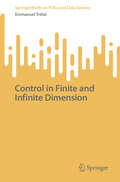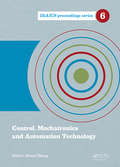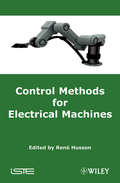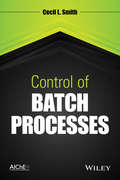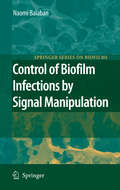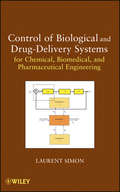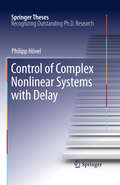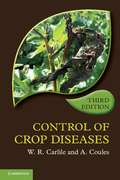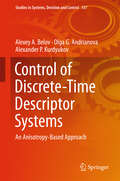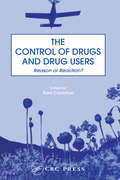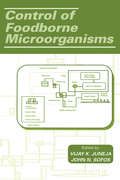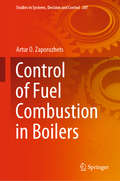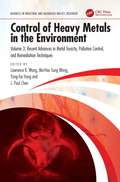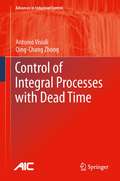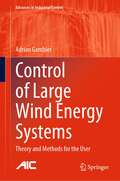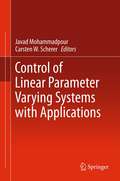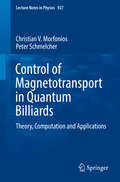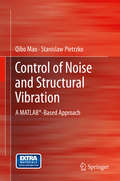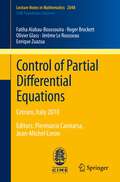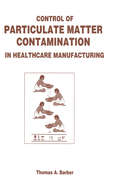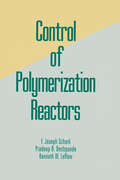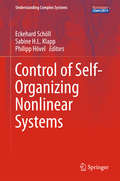- Table View
- List View
Control in Finite and Infinite Dimension (SpringerBriefs on PDEs and Data Science)
by Emmanuel TrélatThis book is the result of various master and summer school courses the author has taught. The objective is to provide the reader with an introduction to control theory and to the main tools allowing to treat general control systems. The author hopes this book will serve as motivation to go deeper into the theory or numerical aspects that are not covered in this book. This book might be helpful for graduate students and researchers in the field of control theory.
Control, Mechatronics and Automation Technology: Proceedings of the International Conference on Control, Mechatronics and Automation Technology (ICCMAT 2014), July 24-25, 2014, Beijing, China (IRAICS Proceedings)
by Dawei ZhengThis proceedings volume contains selected papers presented at the 2014 International Conference on Control, Mechatronics and Automation Technology (ICCMAT 2014), held July 24-25, 2014 in Beijing, China. The objective of ICCMAT 2014 is to provide a platform for researchers, engineers, academicians as well as industrial professionals from all over th
Control Methods for Electrical Machines
by René HussonThe type of control system used for electrical machines depends on the use (nature of the load, operating states, etc.) to which the machine will be put. The precise type of use determines the control laws which apply. Mechanics are also very important because they affect performance. Another factor of essential importance in industrial applications is operating safety. Finally, the problem of how to control a number of different machines, whose interactions and outputs must be coordinated, is addressed and solutions are presented. These and other issues are addressed here by a range of expert contributors, each of whom are specialists in their particular field. This book is primarily aimed at those involved in complex systems design, but engineers in a range of related fields such as electrical engineering, instrumentation and control, and industrial engineering, will also find this a useful source of information.
Control of Axially Moving Systems
by Keum-Shik Hong Li-Qun Chen Phuong-Tung Pham Xiao-Dong YangThis book provides a comprehensive guideline on dynamic analysis and vibration control of axially moving systems. First, the mathematical models of various axially moving systems describing the string, beam, belt, and plate models are developed. Accordingly, dynamical issues such as the equilibrium configuration, critical velocity, stability, bifurcation, and further chaotic dynamics are analyzed. Second, this book covers the design of the control schemes based on the hitherto control strategies for axially moving systems: feedback control using the transfer function, variable structure control, control by regulating the axial velocity, wave cancellation approach, boundary control using the Lyapunov method, adaptive control, and hybrid control methods. Finally, according to the contents discussed in the book, specific aspects are outlined for initiating future research endeavors to be undertaken concerning axially moving systems. This book is useful to graduate students and researchers in industrial sectors such as continuous manufacturing systems, transport systems, power transmission systems, and lifting systems not to mention in academia.
Control of Batch Processes
by Cecil L. SmithGives a real world explanation of how to analyze and troubleshoot a process control system in a batch process plant* Explains how to analyze the requirements for controlling a batch process, develop the control logic to meet these requirements, and troubleshoot the process controls in batch processes* Presents three categories of batch processes (cyclical batch, multigrade facilities, and flexible batch) and examines the differences in the control requirements in each* Examines various concepts of a product recipe and what its nature must be in a flexible batch facility* Approaches the subject from the process perspective, with emphasis on the advantages of using structured logic in the automation of all but the simplest batch processes.* Discusses the flow of information starting at the plant floor and continuing through various levels of the control logic up to the corporate IT level
Control of Biofilm Infections by Signal Manipulation (Springer Series on Biofilms #2)
by Naomi Balaban J. W. CostertonThe number of patients affected by and dying from what can be considered as a "biofilm disease" is higher than heart disease and cancer combined. Thus, this is a hugely important work that describes the molecular mechanisms of cell-to-cell communication among bacterial cells in a biofilm, the development of antibiofilm inhibitors such as quorum-sensing inhibitors, and the use of biofilm inhibitors to prevent and treat bacterial infections in humans and other animals.
Control of Biological and Drug-Delivery Systems for Chemical, Biomedical, and Pharmaceutical Engineering
by Laurent SimonEnables readers to apply process dynamics and control theory to solve bioprocess and drug delivery problemsThe control of biological and drug delivery systems is critical to the health of millions of people worldwide. As a result, researchers in systems biology and drug delivery rely on process dynamics and control theory to build our knowledge of cell behavior and to develop more effective therapeutics, controlled release devices, and drug administration protocols to manage disease.Written by a leading expert and educator in the field, this text helps readers develop a deep understanding of process dynamics and control theory in order to analyze and solve a broad range of problems in bioprocess and drug delivery systems. For example, readers will learn how stability criteria can be used to gain new insights into the regulation of biological pathways and lung mechanics. They'll also learn how the concept of a time constant is used to capture the dynamics of diffusive processes. Readers will also master such topics as external disturbances, transfer functions, and input/output models with the support of the author's clear explanations, as well as:Detailed examples from the biological sciences and novel drug delivery technologies160 end-of-chapter problems with step-by-step solutionsDemonstrations of how computational software such as MATLAB and Mathematica solve complex drug delivery problemsControl of Biological and Drug-Delivery Systems for Chemical, Biomedical, and Pharmaceutical Engineering is written primarily for undergraduate chemical and biomedical engineering students; however, it is also recommended for students and researchers in pharmaceutical engineering, process control, and systems biology. All readers will gain a new perspective on process dynamics and control theory that will enable them to develop new and better technologies and therapeutics to treat human disease.
Control of Complex Nonlinear Systems with Delay (Springer Theses)
by Philipp HövelThis research addresses delay effects in nonlinear systems, which are ubiquitous in various fields of physics, chemistry, biology, engineering, and even in social and economic systems. They may arise as a result of processing times or due to the finite propagation speed of information between the constituents of a complex system. Time delay has two complementary, counterintuitive and almost contradictory facets. On the one hand, delay is able to induce instabilities, bifurcations of periodic and more complicated orbits, multi-stability and chaotic motion. On the other hand, it can suppress instabilities, stabilize unstable stationary or periodic states and may control complex chaotic dynamics. This thesis deals with both aspects, and presents novel fundamental results on the controllability of nonlinear dynamics by time-delayed feedback, as well as applications to lasers, hybrid-mechanical systems, and coupled neural systems.
Control of Crop Diseases
by W. R. Carlile A. CoulesThoroughly revised and updated to reflect current and emerging practices, this book explores modern methods of disease control in field and glasshouse crops. It outlines the major crop diseases, with a particular emphasis on those features of symptomology and life cycle that are most relevant to the development of control measures. Modern diagnostic techniques are considered, focusing on developments in nucleic acid and immunological based procedures and their use in plant quarantine and certification schemes. The potential impact of these advances in molecular technology on plant breeding and disease resistance is also covered. Fungicides are a central part of disease control in the EU and, as such, a comprehensive account of their use forms an important part of the text, along with strategies to minimise the incidence of fungicide resistance in pathogen populations. Looking to the future, the book also addresses legislative, environmental and food safety concerns.
Control of Discrete-Time Descriptor Systems: An Anisotropy-based Approach (Studies In Systems, Decision And Control #157)
by Alexey A. Belov Olga G. Andrianova Alexander P. KurdyukovControl of Discrete-Time Descriptor Systems takes an anisotropy-based approach to the explanation of random input disturbance with an information-theoretic representation. It describes the random input signal more precisely, and the anisotropic norm minimization included in the book enables readers to tune their controllers better through the mathematical methods provided. The book contains numerous examples of practical applications of descriptor systems in various fields, from robotics to economics, and presents an information-theoretic approach to the mathematical description of coloured noise. Anisotropy-based analysis and design for descriptor systems is supplied along with proofs of basic statements, which help readers to understand the algorithms proposed, and to undertake their own numerical simulations. This book serves as a source of ideas for academic researchers and postgraduate students working in the control of discrete-time systems. The control design procedures outlined are numerically effective and easily implementable in MATLAB®
The Control of Drugs and Drug Users: Reason or Reaction?
by Ross CoomberInformed debate on how, why, or even if, drugs and those that use them should be controlled needs an insight into the background of such controls, how effective they have been and what reasonable alternatives there may be. This book seeks to provide such an insight. Reviewing important aspects of past and current drug control policies in Britain and America, the international compliment of expert contributors seek to explore the rationality of the reasoning which produced the initial controls, the continuing relevance of those currently employed, and provide alternative scenarios for future policy.
Control of Foodborne Microorganisms
by Vijay K. Juneja John N. SofosPresents the latest research in the control of foodborne pathogens. Emphasizes traditional and emerging techniques as well as current applications for the inactivation of microorganisms to reduce illness and enhance food safety and quality.
Control of Fuel Combustion in Boilers (Studies in Systems, Decision and Control #287)
by Artur O. ZaporozhetsThis book examines key issues in improving the efficiency of small and medium power boiler units by adding control systems for the fuel combustion process. The original models, algorithms, software and hardware of the system developed for controlling the fuel combustion process are presented. In turn, the book presents a methodology for assessing the influence of climatic factors on the combustion process, and proposes new methods for measuring the thermophysical characteristics, which require taking into account the concentration of oxygen in the air. The system developed here was implemented on a boiler of the NIISTU-5 type, which is widely used for heat power engineering in Ukraine and other Eastern European countries. Given its scope, the book offers a valuable asset for researchers and engineers, as well as lecturers and graduate students at higher education institutions dealing with heat engineering equipment.
Control of Heavy Metals in the Environment: Recent Advances in Metal Toxicity, Pollution Control, and Remediation Techniques (Advances in Industrial and Hazardous Wastes Treatment)
by Lawrence K. Wang Wang, Mu-Hao Sung Yung-Tse Hung J. Paul ChenOffering broad coverage of advanced principals and applications, Control of Heavy Metals in the Environment series provides chemical and environmental engineers with the most complete resource available on the treatment of heavy metal contaminants with an emphasis on advanced and alternative approaches. It investigates a variety of environmental pollution sources and waste characteristics that require a multitude of remediation methods. It covers metal oxide nanoparticle pollution and nanotechnology applications for remediation. The authors delve into costs and effluent standards and offer several illustrative case histories to illustrate the regional and global effects of key pollution control practices.Features: Provides technical information for industrial and hazardous waste treatment. Explores the newest methods of clean production and waste minimization. Covers topics related to environmental geochemistry. Includes numerous figures, tables, examples, and case histories.
Control of Innate and Adaptive Immune Responses during Infectious Diseases
by Julio AlibertiUpon infection the host needs to mount vigorous immune response against pathogen in order to successfully control its replication. However, once the infectious agent is controlled or eliminated, host cells need to signal the immune system to slow or cease its activities. While vast knowledge has been accumulated through the years on the mechanisms involved in the initiation and effector phases of the immune responses, the pathways triggered in order to modulate or end innate and acquired immunity are becoming more evident as evidence for its relevance comes to surface. Due to its biological power, evidence has surfaced indicating that eventually pathogens may take advantage of such regulatory pathways in order to escape effector mechanisms and progress to persistence. This book will discuss several cellular pathways involved in controlling immune response in the context of infectious diseases, their biological consequences and potential "hijack" of these pathways for the benefit of pathogen leading towards pathogen persistence as opposed to clearance.
Control of Integral Processes with Dead Time (Advances in Industrial Control)
by Antonio Visioli Qingchang ZhongControl of Integral Processes with Dead Time provides a unified and coherent review of the various approaches devised for the control of integral processes, addressing the problem from different standpoints. In particular, the book treats the following topics: How to tune a PID controller and assess its performance; How to design a two-degree-of-freedom control scheme in order to deal with both the set-point following and load disturbance rejection tasks; How to modify the basic Smith predictor control scheme in order to cope with the presence of an integrator in the process; and how to address the presence of large process dead times. The methods are presented sequentially, highlighting the evolution of their rationale and implementation and thus clearly characterising them from both academic and industrial perspectives.
Control of Large Wind Energy Systems: Theory and Methods for the User (Advances in Industrial Control)
by Adrian GambierWind energy systems are central contributors to renewable energy generation, and their technology is continuously improved and updated. Without losing sight of theory, Control of Large Wind Energy Systems demonstrates how to implement concrete control systems for modern wind turbines, explaining the reasons behind choices and decisions. This book provides an extended treatment of different control topics divided into three thematic parts including modelling, control and implementation. Solutions for real-life difficulties such as multi-parameter tuning of several controllers, curve fitting of nonlinear power curves, and filter design for concrete signals are also undertaken. Examples and a case study are included to illustrate the parametrization of models, the control systems design with problems and possible solutions. Advice for the selection of control laws, calculation of specific parameters, which are necessary for the control laws, as the sensitivity functions, is given, as well as an evaluation of control performance based on indices and load calculation. Control of Large Wind Energy Systems covers methodologies which are not usually found in literature on this topic, including fractional order PID and nonlinear PID for pitch control, peak shaving control and extremum seeking control for the generator control, yaw control and shutdown control. This makes it an ideal book for postgraduate students, researchers and industrial engineers in the field of wind turbine control. Advances in Industrial Control reports and encourages the transfer of technology in control engineering. The rapid development of control technology has an impact on all areas of the control discipline. The series offers an opportunity for researchers to present an extended exposition of new work in all aspects of industrial control.
Control of Linear Parameter Varying Systems with Applications
by Carsten W. Scherer Javad MohammadpourControl of Linear Parameter Varying Systems compiles state-of-the-art contributions on novel analytical and computational methods for addressing system identification, model reduction, performance analysis and feedback control design and addresses address theoretical developments, novel computational approaches and illustrative applications to various fields. Part I discusses modeling and system identification of linear parameter varying systems, Part II covers the importance of analysis and control design when working with linear parameter varying systems (LPVS) , Finally, Part III presents an applications based approach to linear parameter varying systems, including modeling of a turbocharged diesel engines, Multivariable control of wind turbines, modeling and control of aircraft engines, control of an autonomous underwater vehicles and analysis and synthesis of re-entry vehicles.
Control of Magnetotransport in Quantum Billiards: Theory, Computation and Applications (Lecture Notes in Physics #927)
by Christian V. Morfonios Peter SchmelcherIn this book the coherent quantum transport of electrons through two-dimensional mesoscopic structures is explored in dependence of the interplay between the confining geometry and the impact of applied magnetic fields, aiming at conductance controllability. After a top-down, insightful presentation of the elements of mesoscopic devices and transport theory, a computational technique which treats multiterminal structures of arbitrary geometry and topology is developed. The method relies on the modular assembly of the electronic propagators of subsystems which are inter- or intra-connected providing large flexibility in system setups combined with high computational efficiency. Conductance control is first demonstrated for elongated quantum billiards and arrays thereof where a weak magnetic field tunes the current by phase modulation of interfering lead-coupled states geometrically separated from confined states. Soft-wall potentials are then employed for efficient and robust conductance switching by isolating energy persistent, collimated or magnetically deflected electron paths from Fano resonances. In a multiterminal configuration, the guiding and focusing property of curved boundary sections enables magnetically controlled directional transport with input electron waves flowing exclusively to selected outputs. Together with a comprehensive analysis of characteristic transport features and spatial distributions of scattering states, the results demonstrate the geometrically assisted design of magnetoconductance control elements in the linear response regime.
The Control Of Nature
by John McpheeThese three essays center around man's influence on nature and how it (nature) fights back. The First essay centers on New Orleans and how man's influence has contributed to it's now demise. Though written in 1989, Mcphee's research pretty much describes how Katrina, or in the case of the book, a theoretical storm, could have been made much less destructive had development been much less. The second article discusses efforts in Iceland to cool lava with saltwater and stop the destruction of a town. The third describes Los Angeles's expansion and possible demise due to run off and mud slides from the San Gabriel mountains. His premise in all three articles basically is, nature will ultimately have the last word in it's ultimate design.
Control of Noise and Structural Vibration: A MATLAB®-Based Approach
by Qibo Mao Stanislaw PietrzkoControl of Noise and Structural Vibration presents a MATLAB®-based approach to solving the problems of undesirable noise generation and transmission by structures and of undesirable vibration within structures in response to environmental or operational forces. The fundamentals of acoustics, vibration and coupling between vibrating structures and the sound fields they generate are introduced including a discussion of the finite element method for vibration analysis. Following this, the treatment of sound and vibration control begins, illustrated by example systems such as beams, plates and double walls. Sensor and actuator placement is explained as is the idea of modal sensor-actuators. The design of appropriate feedback systems includes consideration of basic stability criteria and robust active structural acoustic control. Positive position feedback (PPF) and multimode control are also described in the context of loudspeaker-duct and loudspeaker-microphone models. The design of various components is detailed including the analog circuit for PPF, adaptive (semi-active) Helmholtz resonators and shunt piezoelectric circuits for noise and vibration suppression. The text makes extensive use of MATLAB® examples and these can be simulated using files available for download from the book's webpage at springer.com. End-of-chapter exercises will help readers to assimilate the material as they progress through the book. Control of Noise and Structural Vibration will be of considerable interest to the student of vibration and noise control and also to academic researchers working in the field. It's tutorial features will help practitioners who wish to update their knowledge with self-study.
Control of Partial Differential Equations: Cetraro, Italy 2010, Editors: Piermarco Cannarsa, Jean-Michel Coron (Lecture Notes in Mathematics #2048)
by Enrique Zuazua Jérôme Le Rousseau Roger Brockett Olivier Glass Jean-Michel Coron Fatiha Alabau-Boussouira Piermarco CannarsaThe term "control theory" refers to the body of results - theoretical, numerical and algorithmic - which have been developed to influence the evolution of the state of a given system in order to meet a prescribed performance criterion. Systems of interest to control theory may be of very different natures. This monograph is concerned with models that can be described by partial differential equations of evolution. It contains five major contributions and is connected to the CIME Course on Control of Partial Differential Equations that took place in Cetraro (CS, Italy), July 19 - 23, 2010. Specifically, it covers the stabilization of evolution equations, control of the Liouville equation, control in fluid mechanics, control and numerics for the wave equation, and Carleman estimates for elliptic and parabolic equations with application to control. We are confident this work will provide an authoritative reference work for all scientists who are interested in this field, representing at the same time a friendly introduction to, and an updated account of, some of the most active trends in current research.
Control of Particulate Matter Contamination in Healthcare Manufacturing
by Thomas A. BarberWritten by an expert in the industry, this text addresses the specifics of contamination, including particle origination, characterization, identification, and elimination, with a special focus on quality. The author offers a clear and concise review of particle populations and their control in stability, efficacy, and predictability in the manufacture of healthcare products. He brings together information from over 100 Web sites and other sources and casts it into a practical framework that will help readers ensure their company's success. The book contains thirty-two color photomicrographs and over eighty figures, tables, and charts.
Control of Polymerization Reactors
by F. Joseph Schurk Pradeep B. Deshpande Kenneth W. Leffew Vikas M. NadkarniThis reference and text provides an in-depth description of developments in control techniques and their application to polymerization reactors and offers important introductory background information on polymerization reaction engineering.;Discussing modelling, identification, linear, nonlinear and multivariable schemes, Control of Polymerization Reactors: presents all available techniques that can be used to control reactors properly for optimal performance; shows how to manipulate pivotal variables that affect reactor control; examines methods for deriving dynamic process models to improve reactor efficiency; reviews reactor control problems and points out end-use properties; supplies methods for measuring process variables, and ways to estimate variables that can't be measured; and explains how single-input, single-output (SISO) strategies can be effectively used for control.;Filled with illustrative examples to clarify concepts, including more than 730 figures, tables and equations, Control of Polymerization Reactors is intended for use as a reference for chemical, process development, process design, research and development, control systems, and polymer engineers; and polymer chemists and physicists; as well as a text for upper-level undergraduate and graduate students in polymerization reactor control courses.
Control of Self-Organizing Nonlinear Systems (Understanding Complex Systems)
by Philipp Hövel Eckehard Schöll Sabine H. L. KlappThe book summarizes the state-of-the-art of research on control of self-organizing nonlinear systems with contributions from leading international experts in the field. The first focus concerns recent methodological developments including control of networks and of noisy and time-delayed systems. As a second focus, the book features emerging concepts of application including control of quantum systems, soft condensed matter, and biological systems. Special topics reflecting the active research in the field are the analysis and control of chimera states in classical networks and in quantum systems, the mathematical treatment of multiscale systems, the control of colloidal and quantum transport, the control of epidemics and of neural network dynamics.
